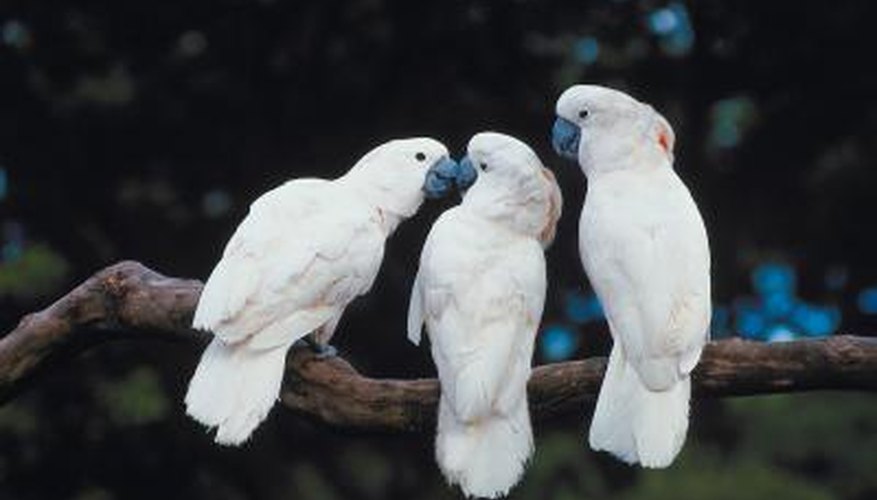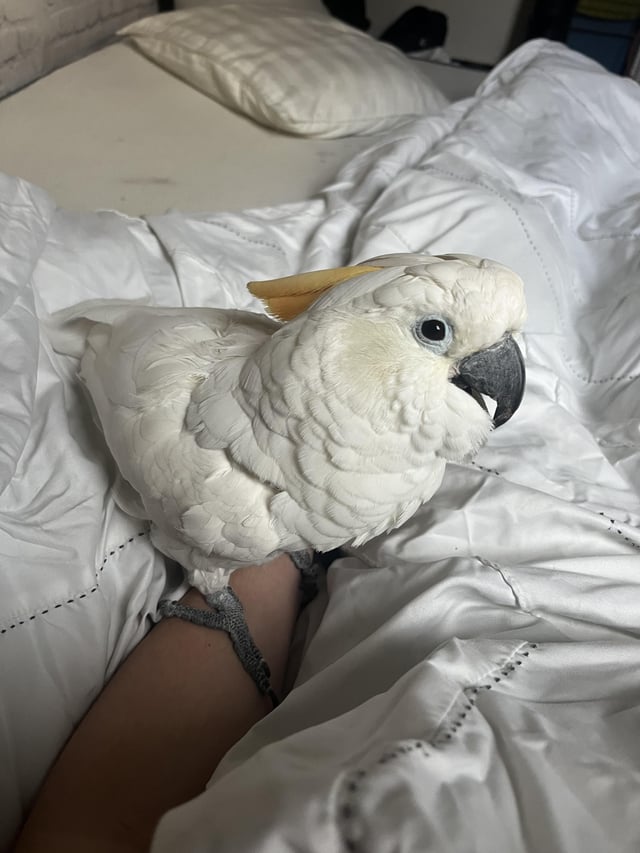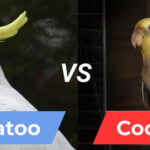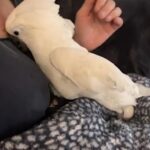Determining a cockatoo’s age can be challenging without a record of its hatch date. Visual aging cues are subtle and require expertise to interpret.
Unveiling the age of a cockatoo often feels like solving a nature’s puzzle. These charismatic birds, known for their intelligence and longevity, do not exhibit obvious signs of aging like humans do. Once they reach maturity, changes in features such as feather color and eyes are minimal and not reliable for age determination.
A bird expert or avian veterinarian might look for signs of wear or arthritis in older birds, but these are not precise indicators. The best method to know a cockatoo’s exact age is through documentation from the time of its hatching. This underscores the importance of purchasing birds from reputable breeders or adopt from sanctuaries that maintain thorough records. For cockatoo enthusiasts, understanding the challenges in age determination can lead to a deeper appreciation of these fascinating birds and their care requirements.
The Complexity Of Aging Avians
Understanding the age of a cockatoo can be quite a puzzle. These beautiful birds hide their years behind feathers and behaviors that often remain youthful throughout their lives. Though their exact age may be shrouded in mystery, certain indicators can offer clues.
Physical Changes As Age Indicators
Physical signs are among the key indicators of a cockatoo’s age.
- Eyes: Young cockatoos have dark or black eyes, which lighten with age.
- Feathers: Brightness can fade, and older cockatoos might show more wear or scarring on feathers.
- Beak and Nails: Growth layers on beak and nails can indicate age, much like rings on a tree.
| Age Range | Eye Color | Feather Condition | Beak/Nails |
|---|---|---|---|
| Young | Dark/Black | Bright and Intact | Smooth with Few Layers |
| Middle-aged | Lightening | Slight Wear | More Layers Visible |
| Old | Grey or Brown | Noticeable Wear | Multiple Growth Layers |
Challenges In Accurate Aging Of Cockatoos
Several factors complicate determining a cockatoo’s exact age.
- Without a hatch certificate or breeder’s records, estimates are rough.
- Health and diet can influence physical signs, sometimes misleading observers.
- Individual variance means not all birds show age at the same rate.
Consequently, aging a cockatoo requires educated guesses more often than not.
First Glance: Assessing Age By Appearance
Estimating a cockatoo’s age can be tricky yet rewarding. Birds don’t have birth certificates, so owners must turn to physical traits. Let’s uncover the secrets of aging hidden in feathers and eyes.
Evaluating Plumage Condition
Feathers tell tales of time. Young cockatoos sport soft, shiny plumage. As they grow, so does the wear on their feathers. Older birds may show signs of fraying or color changes. These changes happen slowly, reflecting the bird’s life stages.
- Bright, uniform feathers often signify youth.
- Duller, sparse plumage can mean advanced age.
Look for symmetry and cleanliness. Well-preened feathers suggest a younger, more vigorous cockatoo. Observe the bird’s preening habits for further age clues.
Eye Color Transformation Over Time
Like humans, cockatoos’ eyes can change with age. Youngsters usually have dark or grey irises. These gradually lighten to reveal more vivid hues in adult birds.
| Age Bracket | Eye Color Characteristics |
|---|---|
| Youth (0-3 Years) | Darker, uniform irises |
| Adulthood (4-6 Years) | Lighter, brighter irises |
| Senior (7+ Years) | Distinct, pale ring around the pupil |
Watch for a clear, defining ring around the pupil, a common sign of a mature cockatoo. This ring can be an indicator of the bird’s passage into the senior years.
Size And Growth: Clues From Development
Discovering the age of a cockatoo can be a real puzzle. Observing a bird’s size and growth can offer valuable age clues. Let’s look at the development stages of cockatoos, from their youthful milestones to their full-grown size.
Growth Milestones In Juvenile Cockatoos
- Feather development: Newborn cockatoos are featherless — their first feathers are signposts of age.
- Weaning: By about 12 weeks, young birds start eating solid food, waving goodbye to hand-feeding.
- Flight capabilities: At approximately 6 months, their flight skills hint at a maturing juvenile.
Size And Stature In Adulthood
Full-size adult cockatoos showcase their age with a certain stature that you can spot. Unlike juveniles, adults possess a uniform feather pattern and a well-defined crest. Physical growth concludes around 1 to 2 years old.
| Age | Appearance |
|---|---|
| 1-2 years | Reaches full size; crest develops fully. |
| 3-4 years | Stable in size; color deepens. |
| Over 4 years | Consistent size; possible age signs in beak or nails. |

Credit: www.ehow.co.uk
Behavioral Traits As Age Signposts
Understanding a cockatoo’s age can be tricky, as these birds often hide their years well behind a veil of feathers. However, certain changes in behavior can be strong signals of their maturity. Observing these traits can help determine the life stage of a beloved cockatoo.
Shifts In Vocalization Patterns
Cockatoos are known for their vocal abilities. Young cockatoos often experiment with a variety of sounds. As they age, these birds tend to develop a more consistent set of calls. Adult cockatoos may have a set routine of chirps and squawks. Older cockatoos might become less vocal, or their calls may sound different due to changes in their vocal cords.
Activity Levels And Playfulness
Another behavioral marker of age is activity and play. Younger birds are notably more energetic. They’ll often engage in playful antics and have high activity levels. In contrast, older birds show a decline in energy. Their playfulness may wane, and they might prefer resting over romping. This change is gradual and individual to each cockatoo.
- Young Cockatoos:
- High energy play
- Curiosity-driven exploration
- Adult Cockatoos:
- Moderate playfulness
- Established behavior patterns
- Senior Cockatoos:
- Lower activity levels
- More time resting
The Beak: A Tale Of Time
Cockatoos are remarkable creatures, known for their striking features and intelligence. One defining characteristic, their beak, tells much about their age. Just like the rings of a tree, a cockatoo’s beak holds secrets to its years. Let’s discover how changes in texture and color, along with wear and tear, reveal a cockatoo’s age.
Changes In Beak Texture And Color
Young cockatoos have shiny, smooth beaks. As they grow, these beaks change. Texture becomes rougher. Color might darken. These signs are clues about their age.
- Glossy finish indicates youth.
- Roughness suggests maturity.
- Color shifts may signal older age.
Wear And Tear: Analyzing Beak Condition
A cockatoo’s beak goes through much over time. Look for signs of wear and tear. Notches or overgrowth can mean many things.
| Beak Feature | Age Indication |
|---|---|
| Smooth Edges | Less wear, possibly younger bird |
| Notches and Chips | Frequent use, indicates older age |
| Overgrowth | Can signal age or health issue |
Study the beak’s shape and condition. Combine this with texture and color changes. You can piece together a cockatoo’s life story.
Analyzing Feather Health And Molt Cycles
Analyzing Feather Health and Molt Cycles can offer valuable clues about your cockatoo’s age. While determining the exact number of candles to put on your feathery friend’s birthday cake might not be possible, insightful details lie in the pattern and condition of their plumage. Let’s explore how a cockatoo’s feathers serve as a natural timeline to their years.
Molting Frequency And Feather Quality
Molting is a natural process where birds shed old feathers to make room for new growth. Observing the number and frequency of molt cycles can hint at a cockatoo’s maturity. Generally, younger cockatoos molt more as they grow, while adults have steadier, annual molts. Look for these signs:
- Regular molting denotes a mature bird.
- Frequent molting suggests a younger, still-growing cockatoo.
Similarly, feather quality reflects overall health and age. Vibrant, strong feathers indicate a possibly younger and healthier cockatoo. Conversely, older birds might exhibit:
- More worn or frayed feathers.
- A decrease in the sheen and texture of plumage.
The Link Between Stress Bars And Age
Feathers carry history in their very structure. Stress bars, lines across a bird’s feathers, emerge from periods of nutritional deficit or stress. Pinpointing their presence can indicate age changes:
- Young birds with changing diets can display more stress bars.
- Mature birds under less stress might have clearer feathers, free of these markers.
While not an exact science, stress bars can paint a picture of a bird’s growth and life stages. Examine your cockatoo’s feathers for these impressions of their past, and you might just unveil stories of their youth and growth.
Veterinary Insights: Medical Evaluation
Understanding the age of a cockatoo can be quite the mystery. Without a known birth date, veterinarians use medical evaluations to estimate their age. These evaluations look closely at the bird’s physical condition and health history for clues. Let’s dive into some methods vets employ to make an educated guess on a cockatoo’s age.
Bone Density And Muscle Mass
Bone density and muscle mass decline as birds age. Vets use X-rays for a non-invasive look inside a cockatoo’s body. They’re searching for signs of decreased bone density or muscle mass, both indicators of advanced age. Changes in bone structure, such as evidence of arthritis or bone wear, further suggest a cockatoo may be entering its senior years.
Bloodwork And Hormonal Changes Linked To Age
Blood tests are invaluable tools for vets. They reveal hidden health conditions and can indicate a bird’s life stage. Key age-related factors evaluated through bloodwork include:
- Kidney and liver function: These may decline in older birds.
- Calcium and phosphorus levels: Imbalances can show age-related changes.
Leg Bands And Breeder Records
Many wonder about a cockatoo’s age. Leg bands and breeder records are clues. These reliable sources can reveal your cockatoo’s age accurately. If your feathered friend came with these, you’re in luck. Here’s how to decipher the data.
Interpreting Information On Leg Bands
Leg bands are like ID bracelets for birds. They carry unique details. Look closely at the band on your cockatoo’s leg. It tells a story.
- Alphabets stand for the breeder’s initials.
- Numbers might represent the hatching year.
Decoding these can pinpoint the hatch year of your cockatoo.
The Importance Of Breeder And Vet History
Breeder records are gold mines of info.
| Record Type | Details Provided |
|---|---|
| Breeder Records | Hatch date, lineage, and health info. |
| Vet Records | Medical history, age confirmations. |
Pairing records with leg bands ensures the exact age of your cockatoo. Keeping these documents safe is crucial. They aid in accurate age verification. Ensure consultation with avian vets. They match physical signs to recorded data. This method verifies age and maintains health.
The Lifespan Of Cockatoos: A Broad Perspective
Cockatoos boast a colorful personality that matches their vivid feathers. These charming birds are known for their longevity. Understanding the lifespan of cockatoos is essential for prospective and current bird owners. It reflects both the commitment required and the care needed to ensure a healthy life for these parrots.
Typical Lifespan Ranges For Cockatoos
Cockatoos are remarkable for their impressive lifespans. On average, smaller species may live for 20 to 30 years, while larger ones can often reach up to 60 years or more under optimal conditions. Here’s a quick glance at the lifespan ranges for cockatoos:
| Cockatoo Species | Expected Lifespan |
|---|---|
| Goffin’s Cockatoo | 20-30 years |
| Galactic Cockatoo | 40-50 years |
| Sulphur-crested Cockatoo | Up to 70 years |
Each species has its own typical lifespan, though ranges can vary, partly due to the individual bird’s environment and care.
Factors Influencing Longevity
Many factors determine how long a cockatoo will live. Diet, exercise, and environment play pivotal roles. A list of contributors to a cockatoo’s lifespan includes:
- Quality of Diet: A balanced diet fuels a long life.
- Exercise: Regular activity supports physical health.
- Environment: Safe, stimulating habitats contribute to wellbeing.
- Veterinary Care: Regular check-ups catch health issues early.
- Emotional Health: Stress reduction is key for longevity.
- Genetics: Some birds naturally live longer than others.
A well-cared-for cockatoo can be a companion for decades, while neglect can reduce their lifespan dramatically. Owners must commit to providing a loving, enriched, and stable environment.

Credit: www.reddit.com

Credit: www.reddit.com
Conclusion
Determining a cockatoo’s age demands a keen eye and expertise. While physical characteristics offer clues, consulting an avian vet yields the best insights. Regular health check-ups ensure your feathered friend’s vitality, regardless of its life stage. Remember, knowing your cockatoo’s age enhances its care, fostering a joyous, long-lived companionship.
Ryan Everhart is a passionate bird enthusiast and blogger, primarily writing on his website, Avian Whispers. His journey into the world of bird blogging began with a deep interest in parrots, a species that captivated his attention for their intelligence and social behavior. Over time, his content expanded to cover a broader range of bird species, offering insights into bird behavior, care, habitats, and conservation.
Ryan is dedicated to educating his audience, which includes both new bird owners and seasoned enthusiasts. His writing is filled with personal experiences, expert knowledge, and practical advice on bird care. Through Avian Whispers, he aims to foster a deeper appreciation for birds, emphasizing their role in nature and the joys of having them as pets.
Starting with articles focused on parrots, Ryan’s work now encompasses a diverse range of topics such as feeding, training, habitat enrichment, and bird health. His love for birds extends beyond parrots, diving into various avian species. His informative and heartfelt writing reflects his commitment to the well-being of birds and the desire to help others connect with these creatures.
As a growing voice in the bird blogging community, Ryan strives to provide a platform where bird lovers can learn, share experiences, and connect over a shared passion for avian life. His blogs are not only educational but also serve as a reminder of the importance of protecting and nurturing the bond between humans and birds.




